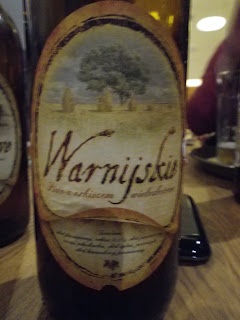Here are two links to web sites that have already started spreading the word about the Gwozdziec synagogue:
scroll down after clicking on the link to the guardians best news pictures of February first.
http://www.guardian.co.uk/news/2013/feb/01/picture-desk-live-the-best-news-pictures-of-the-day1
The second one is a Gazeta of Warsaw article with pictures.
http://warszawa.gazeta.pl/warszawa/1,34862,13336147,Boski_namiot_w_muzeum__Dekoracje_olsniewaja__ZDJECIA_.html
No worries here is Olga's translation:
GORGEOUS TENT IN THE MUSEUM. THE DECORATIONS ARE DAZZLING
This
construction is a masterpiece of timber framing and painted decorations
dazzle with the richness of colors and patterns. The replica of the
Gwoździec synagogue roof is the first assembled piece of the main
exposition of the Museum of History of Polish Jews.
In
the basement of the museum building in Muranów, called also "minus 208
level", one can hear drills whirring and hammers knocking. Team of
several people is working on a wooden structure reminding a tent.
A
complicated skeleton, made out of circa 400 elements, is hanging on
massive chains and slinges, 1.6 m beneath the ground. From below,
temporary beam cribbing provides the support. Thanks to that, without
fear, one can stand underneath and see the ceiling, formed out of more
than 300 hundred boards. It is hard to take eyes off the paintings- You
can see mythical and real animals here, zodiac signs and floral motives.
They all form a visual prayer and lead worshipers towards the East
side, where Aron ha-kodesh altar was situated- explains Rick Brown, in
charge of works.
TWO YEARS OF WORKING IN FIR
The
idea to include this replica the synagogue roof in the gallery
presenting old jewish towns was born long before works on the
construction site have begun. Architects submitting their projects had
to design special place for it. In order to fit such a big construction,
8 m tall, it was necessary to leave a hole in the ceiling between the
basement and the ground floor- We are making a building inside a
buidling- says Robert Supeł, director in charge of the main exposition.
In
2008, american organization called Handhouse Studio from Massachusetts,
contacted the Museum. The Studio, run by Laura and Rick Brown, provides
classes in reconstructing historical wooden objects. They have already
prepared an exhibition about XVII and XVIII century synagogues from
historical Poland. Browns proposed to make especially for the Museum, a
replica of a roof of a wooden synagogue from Gwoździec, near Kołomyja
(today- Ukrainian territories), which was built in the first half of
XVII century. The roof reminded of a tent, hiding a two-level ceiling
over the room of prayers. Paintings were made by two local artists:
Izaak Bar with his son, Israel Liśnicki from Jaryczów, and later- Izaak
Leb, son of Jehuda Hakohen from Jaryczów. - This ceiling was a
breakthrough in the architecture of synagogues, also had it's decorative
value- explains Robert Supeł.
eyes
of specialists, there were 200 Polish, American and Ukrainian students
working on that, during two summer seasons. The construction was made in
the skansen in Sanok, while the paintings- during workshops organised
in the synagogues in various polish towns and cities. Everything was
done with tools and techniques used in the XVII century. Even the same
kind of wood was used for this- silver fir. All the project was funded
by Australian-American donor Irene Pletka.
BEHIND THE FIRE-RESISTANT GLASS
The
replica is slightly smaller than the original. In November it was
brought to Warsaw, in pieces. The install in the building has started on
14th January. Apart from Handhouse Studio, Timber Framers Guild and
polish company Stanko take part in the works. Until now, the frame of
the roof and the ceiling have been installed. In February the frame will
be covered with shingles, but only partly, in order to let the audience
admire complicated combination of the beams. In the beginning of March,
all the construction will be raised on the height of 2.5 m over the
ground. It will be hung on 16 steel rods attached to the ceiling. Thanks
to the hole between two levels, the top part of the rood will be seen
from the ground floor. Just as a priceless exhibit- behind a barrier and
fire resistant glass.
- The most difficult
part was to transform black and white documentation into colour images.
Each element required detailed process, investigation of the history of
architecture, research on the ornaments from this particular period and
area- says Laura Brown.
Similar constructions
were found by the team, in the church of Drohobycz for example. Colours
of the decorations- with major part of blue, red and yellow- they found
in works by painted named Isidor Kaufmann and antropologist named Alois
Breyer, who one hundred years ago were documentating jewish towns in the
eastern border of Poland.
In the basement of
the Museum, other works take place as well. Assembly of steel
construction for the main exhibition is about to finish. This multimedia
exposition- as director Andrzej Cudak has recently announced- is going
to be finished by the beginning of 2014. Top part of the building-
starting from the ground floor- is already finished, in some parts even
furnished.
The opening for the public is
announced for 19th April- it will be part of the celebration of 70th
anniversary of the Ghetto Uprising.
Hugs!
O.
------------------------------
olgamicinska.tumblr.com

















































